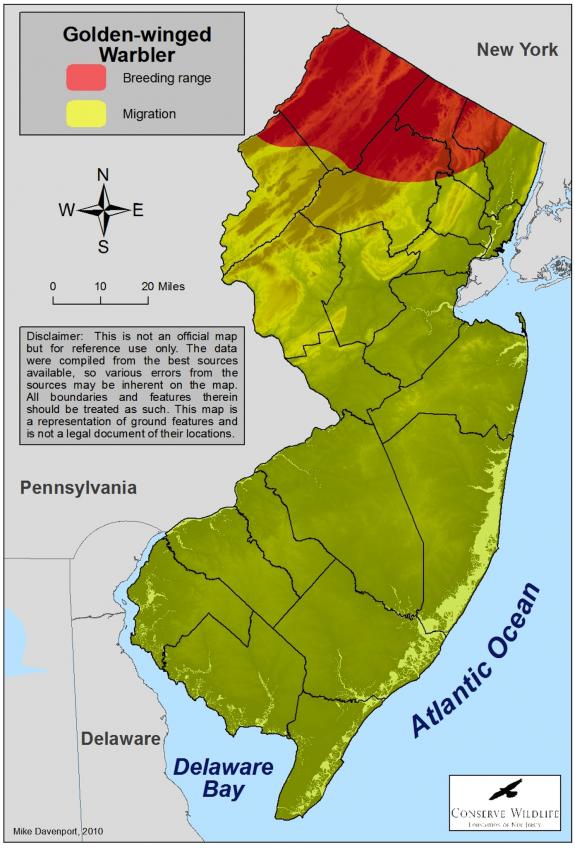Vermivora chrysoptera
Type: bird
Status: endangered
Species Guide
Golden-winged warbler
Vermivora chrysoptera
Species Type: bird
Conservation Status: endangered
IDENTIFICATION
The golden-winged warbler is a small attractive bird only 4.8 inches in length. The sexes look different during the breeding season with the male sporting more flashy plumage. The male has gray upperparts with a bright yellow cap during the breeding season. He also has a black throat and eye patch, a yellow patch on his wings, and a white underside.
The female’s upperparts are more olive-green with a duller yellow cap. Her throat and eye patch are also duller than the male’s, blending into her upperparts.

Distribution & Habitat
The breeding range of the golden-winged warbler extends along the Appalachians from the northern portion of Georgia in the south to Vermont in the north. The northern portion of this breeding range extends westward into Minnesota. The winter range for this species is southern Mexico and Central America.
In New Jersey, golden-winged warblers may be observed as a migrant throughout the entire state. It has only been documented to breed within the northwestern portion of the state though.
Golden-winged warblers breed in wet scrub/shrub habitat, marshes, and bogs on the edge of woodlands, usually within early successional habitat only. They prefer openings within deciduous woodland with thick undergrowth. They can often be found within areas bordering woodland and marsh which have been cut for utility right-of-ways, such as powerlines.
Diet
Like many wood warblers, golden-winged warblers are insectivorous. They glean small insects from twigs and leaves.
Life Cycle
Breeding season for the golden-winged warbler may begin as early as April and then usually ends in August. Multiple pairs of birds may nest in close proximity. The golden-winged warbler’s nest is built by the female and is usually constructed on or near the ground, often concealed in vegetation at the base of a shrub or tree. 4 or 5 eggs are typically laid and only the female incubates them, which may last 8 to 10 days. The young are cared for by both parents and will leave the nest at about 10 days old.
Current Threats, Status, and Conservation
The golden-winged warbler is uncommon to rare and declining throughout most of its range. One possible cause for the decline is habitat loss within its breeding, wintering, and migration range. Their population may also be declining as a result of the influx of the closely-related blue-winged warbler (Vermivora pinus) which has been moving northward in recent years, into the range of the golden-winged warbler. Blue-wings and golden-wings may compete with each other for food, nest sites, and even mates! Because they are so closely related, the two species are known to hybridize. Hybrids of these two species are neither blue-winged nor golden-winged warblers; rather, they are known as either Brewster’s warbler or Lawrence’s warbler.
Because of the steep decline in their population within New Jersey, the golden-winged warbler was listed as an Endangered species in 2012.
References
Text written by Michael J. Davenport in 2011 and edited in 2012.
Scientific Classification
- Kingdom: Animalia
- Phylum: Chordata
- Class: Aves
- Order: Passeriformes
- Family: Parulidae
- Genus: Vermivora
- Species: V. chrysoptera